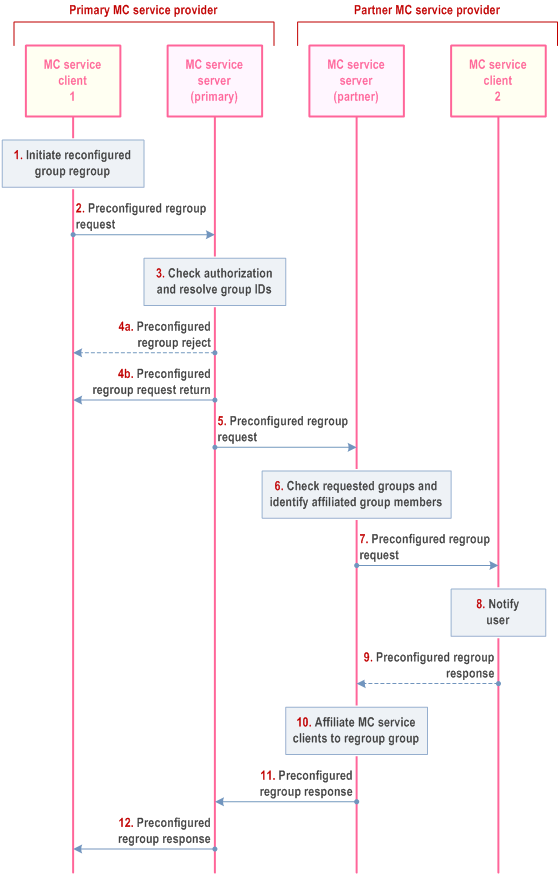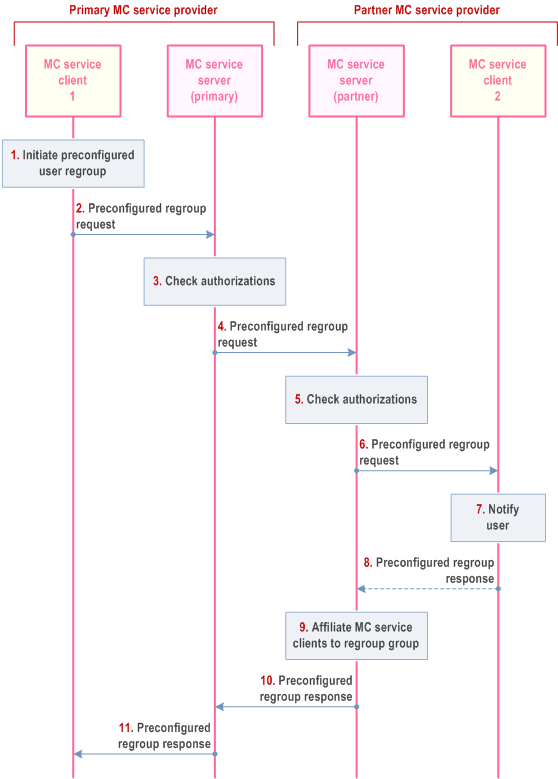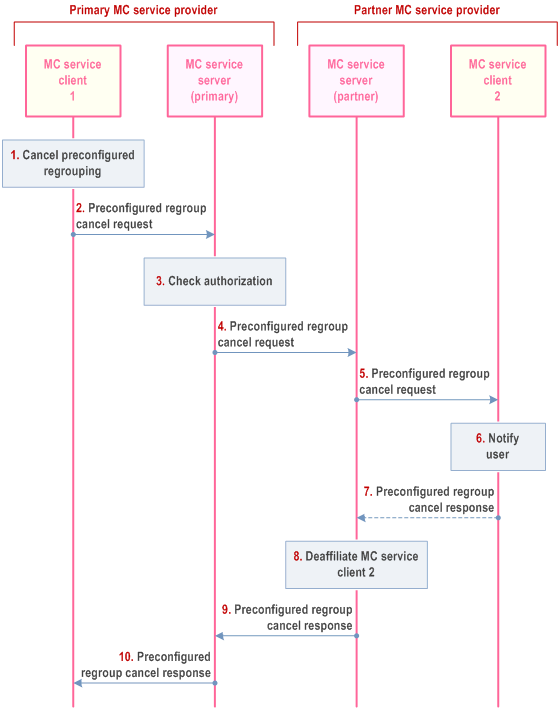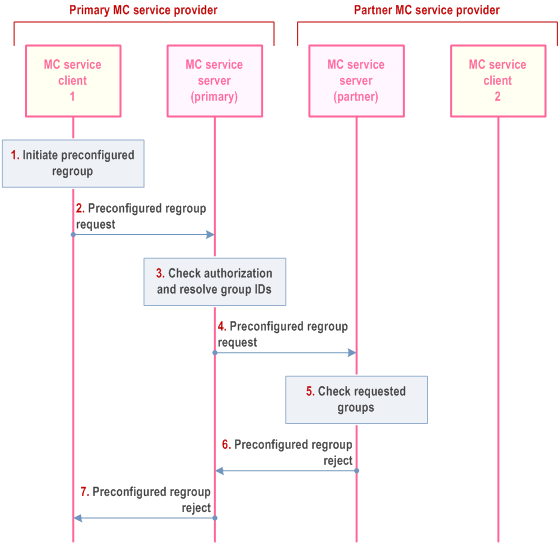Content for TS 23.280 Word version: 19.2.0
1…
5…
5.2.8…
6
7…
7.3.2
7.4…
7.4.3…
7.5…
8…
9…
9.2.2…
9.2.2.2…
9.3…
10…
10.1.2…
10.1.3…
10.1.4.3…
10.1.4.5…
10.1.5…
10.1.6…
10.2…
10.2.3…
10.2.4.2…
10.2.4.3…
10.2.5…
10.2.7…
10.3…
10.6…
10.7…
10.7.3…
10.7.3.4…
10.7.3.7…
10.7.3.7.3
10.7.3.8…
10.7.3.10…
10.8…
10.8.4…
10.8.5…
10.9…
10.9.3…
10.9.3.5…
10.9.3.8…
10.9.3.9…
10.9.3.9.3…
10.9.3.9.4…
10.9.3.10…
10.9.3.10.4…
10.9.3.10.6…
10.10…
10.10.1.2.3…
10.10.2…
10.10.3…
10.10.3.3…
10.10.3.4…
10.11…
10.11.5…
10.12…
10.13…
10.13.3…
10.13.7…
10.13.10…
10.14…
10.15…
10.15.3…
10.15.3.3…
10.15.3.4…
10.16…
10.17…
10.17.3…
10.17.5…
11…
11.3…
11.5…
11.5.2…
11.5.3…
11.5.3.3.2A…
11.5.4…
A…
B…
C…
10.15.3.3 Preconfigured regroup procedures in multiple MC systems
10.15.3.3.1 Preconfigured Group Regroup formation in multiple MC systems
10.15.3.3.2 Preconfigured User Regroup formation in multiple MC systems
10.15.3.3.3 Preconfigured regroup cancellation in multiple MC systems
10.15.3.3.4 Preconfigured group regroup rejection in multiple MC systems
...
...
10.15.3.3 Preconfigured regroup procedures in multiple MC systems p. 293
The following subclauses define group and user regroup procedures using preconfigured groups in multiple MC systems.
10.15.3.3.1 Preconfigured Group Regroup formation in multiple MC systems p. 294
Figure 10.15.3.3.1-1 illustrates the procedure to initiate a group regroup procedure using a preconfigured MC service group, where at least one of the groups to be regrouped is configured in a partner MC system. The primary MC system where the preconfigured group regrouping is initiated does not need to be aware of the list of group members belonging to groups whose group home system is the partner MC system. If the group management server in the primary MC system of the MC service regroup group shares the necessary security related parameters together with the group configuration of the preconfigured MC service group with the group management server in the partner MC system and the group management server in the partner MC system distributes this configuration including those security parameters to its served MC service users according to the procedures in subclause 10.2.7, the primary MC system does not need to be aware of the list of group members of the MC service regroup group that are receiving service in the partner MC system.
The procedure takes place prior to the establishment of a group call to the MC service regroup group.
In this procedure, any gateway MC servers in the primary or partner MC systems are not shown.
Pre-conditions:
- MC service client 1 is authorized to initiated a preconfigured regroup procedure, and is receiving MC service in the primary MC system of MC service client 1.
- MC service client 2 is an affiliated member of MC service group 1 where MC service group 1 is defined in the partner MC system and MC service client 2 is receiving service in the partner MC system of MC service client 1.
- The preconfigured MC service group have been preconfigured in MC service client 2, and MC service client 2 has received the relevant security related information to allow communication in the MC service regroup group.
- In order to be aware whether the group is regrouped, the MC service server is subscribed to the group configuration in the GMS.
- The GMS has subscribed to group dynamic data from the MC service server within the same MC system using the procedures defined in subclause 10.1.5.6

Step 1.
After the group regrouping procedure, the regrouping remains in effect until explicitly cancelled by the procedure in clause 10.15.3.3.3.
MC service client participation in the ongoing regroup persists until the MC service client is no longer affiliated to any of the regrouped groups (group 1 or 2 in this procedure).
MC service client affiliation to the regroup group may cease when the UE's MC service ceases, e.g. when the UE is powered down, or by performing a log-off operation.
The authorized user of MC service client 1 initiates the group regroup procedure, specifying the list of MC service groups to be regrouped including MC service group 1, the MC service group ID of the regroup group (if available) and the MC service group ID of the group from which configuration information for the regroup group is to be taken.
Step 2.
MC service client 1 sends the preconfigured regroup request to the MC service server.
Step 3.
The MC service server checks that MC service client 1 is authorized to initiate a preconfigured group regroup procedure, and resolves the group identities of the MC service groups requested in step 1. The MC service server also checks which group members are affiliated to the requested MC service groups that are homed in the primary MC system. The MC service server identifies any partner systems which are the group home systems for MC service groups identified in the list of groups to be regrouped. The MC service server may retrieve the configuration for the regroup group from the GMS if that configuration information is not already known to the MC service server. The MC service server also checks that none of the MC service groups that are homed in the primary MC system and that are requested for regrouping are already regrouped by any mechanism. If the preconfigured regroup request is authorized, the MC service server assigns a MC service group ID for this regroup group if:
Step 4a.
- one is not provided in the request, or
- the one provided in the request is not accepted.
If the MC service server determines that any of the groups requested for regrouping, including the regroup group, have been regrouped by other group regrouping procedures, the MC service server then sends a preconfigured regroup reject back to MC service client 1 with a reject reason indicating that one of the groups has already been regrouped, and this procedure terminates.
Step 4b.
The MC service server shall send the preconfigured regroup request return message to MC service client 1 containing the below:
Step 5.
- result of whether the preconfigured regroup is authorized or not; and
- the MC service group ID if authorized
The MC service server sends the preconfigured regroup requests to the MC service server in the partner MC system.
Step 6.
The partner MC service server checks the status of any MC service groups hosted by that partner MC service server, and identifies affiliated group members of any of the identified MC service groups (both MC service groups that are hosted in the primary MC system and MC service groups that are hosted in the partner MC system) that are receiving MC service service in the partner MC system, which include MC service client 2.
Step 7.
The partner MC service server sends the preconfigured regroup request to MC service client 2.
Step 8.
MC service client 2 notifies the user of the regrouping.
Step 9.
MC service client 2 may send the preconfigured regroup response to the partner MC service server to acknowledge the regrouping action. This acknowledgement is not sent in response to a multicast transmission of the preconfigured regroup request.
Step 10.
The partner MC service server affiliates the regrouped MC service client 2 to the regroup group.
Step 11.
The partner MC service server sends a preconfigured regroup response to the primary MC service server.
Step 12.
The primary MC service server sends the preconfigured regroup response to MC service client 1.
10.15.3.3.2 Preconfigured User Regroup formation in multiple MC systems p. 296
Figure 10.15.3.3.2-1 illustrates the procedure to initiate a user regroup procedure using a preconfigured MC service group, where at least one of the MC service users to be regrouped is homed in a partner MC system. It is assumed that the group management server in the primary MC system of the MC service regroup group shares the necessary security related parameters together with the group configuration of the preconfigured MC service group with the group management server in the partner MC system and the group management server in the partner MC system distributes this configuration including those security parameters to its served MC service users according to the procedures in subclause 10.2.7.
The procedure takes place prior to the establishment of a group call to the MC service regroup group.
In this procedure, any gateway MC servers in the primary or partner MC systems are not shown.
Pre-conditions:
- MC service client 1 is homed in the primary MC system and is receiving service in the primary MC system.
- MC service client 2 is homed in the partner MC system and is receiving service in the partner MC service system of MC client 1.
- The MC service group identity and group configuration for the preconfigured MC service group have been preconfigured in MC service client 2, and MC service client 2 has received the relevant security related information to allow communication in the MC service regroup group.
- MC service client 1 is authorized to initiate a preconfigured user regroup procedure.
- MC service client 1 is aware of a suitable preconfigured group whose configuration has been preconfigured in the MC service UEs of the MC service users who will be regrouped.

Step 1.
The authorized user of MC service client 1 initiates the user regroup procedure, specifying the list of MC service users to be regrouped including MC service client 2, the MC service group ID of the regroup group, and the MC service group ID of the group from which configuration information for the regroup group is to be taken.
Step 2.
MC service client 1 sends the preconfigured regroup request to the primary MC service server. The request indicates the list of users to be included in the regroup operation.
Step 3.
The primary MC service server checks that MC service client 1 is authorized to initiate a preconfigured user regroup procedure.
Step 4.
The primary MC service server sends the preconfigured regroup requests to the MC service server in the partner MC system.
Step 5.
The partner MC service server checks that the primary MC service server is authorized to include MC service users homed in the partner system.
Step 6.
The partner MC service server sends the preconfigured regroup request to MC service client 2.
Step 7.
MC service client 2 notifies the user of the regrouping.
Step 8.
MC service client 2 may send the preconfigured regroup response to the partner MC service server to acknowledge the regrouping action. This acknowledgement is not sent in response to a multicast transmission of the preconfigured regroup request.
Step 9.
The partner MC service server affiliates the regrouped MC service client 2 to the regroup group.
Step 10.
The partner MC service server sends a preconfigured regroup response to the primary MC service server.
Step 11.
The primary MC service server sends the preconfigured regroup response to MC service client 1.
10.15.3.3.3 Preconfigured regroup cancellation in multiple MC systems p. 298
Figure 10.15.3.3.3-1 illustrates the procedure to cancel a group or user regroup that uses a preconfigured MC service group where multiple MC systems were involved in the regrouping.
Pre-conditions:
- MC service client 2 has been regrouped into the MC service regroup group, and is receiving service in the partner MC system of the regroup group.
- MC service client 1 is authorized to cancel a regrouping that uses a preconfigured MC service group, and is receiving service in the primary MC system of the regroup group.
- The GMS has subscribed to group dynamic data from the MC service server within the same MC system using the procedures defined in subclause 10.1.5.6.

Step 1.
The authorized user of MC service client 1 initiates the cancellation of the regrouping that uses a preconfigured MC service group.
Step 2.
MC service client 1 sends the preconfigured regroup cancel request to the MC service server, specifying the MC service group ID of the regroup group.
Step 3.
The MC service server checks that MC service client 1 is authorized to cancel a regrouping that uses a preconfigured group regroup procedure.
Step 4.
The primary MC service server sends the regroup cancel request to the partner MC service server.
Step 5.
The partner MC service server sends the preconfigured regroup cancel requests to MC service client 2.
Step 6.
MC service client 2 notifies the user of the cancellation of the group regrouping.
Step 7.
MC service client 2 may send the preconfigured regroup cancel response to the partner MC service server to acknowledge the cancellation of the regrouping function. This acknowledgement is not sent in response to a multicast transmission of the preconfigured regroup cancel request.
Step 8.
The partner MC service server deaffiliates MC service client 2 from the MC service regroup group.
Step 9.
The partner MC service server sends the preconfigured regroup cancel response to the primary MC service server.
Step 10.
The primary MC service server sends a preconfigured regroup cancel response to MC service client 1.
10.15.3.3.4 Preconfigured group regroup rejection in multiple MC systems p. 299
Figure 10.15.3.3.4-1 illustrates the case where the procedure to initiate a group regroup with multiple MC systems using a preconfigured MC service group described in subclauses 10.15.3.3.1 commences, but where the request for the regroup is rejected by the partner MC service server. The rejection can occur, for example because one of the groups hosted by the partner MC service server is already regrouped by other group regrouping procedures.
In this procedure, any gateway MC servers in the primary or partner MC systems are not shown.
Pre-conditions:
- MC service client 1 is authorized to initiated a preconfigured regroup procedure, and is receiving MC service in the primary MC system of MC service client 1.
- In order to be aware whether the group is regrouped, the MC service server within the same MC system is subscribed to the group configuration in the GMS.

Step 1.
The authorized user of MC service client 1 initiates the group regroup procedure, specifying the list of MC service groups to be regrouped including MC service group 1, the MC service group ID of the regroup group and the MC service group ID of the group from which configuration information for the regroup group is to be taken.
Step 2.
MC service client 1 sends the preconfigured regroup request to the MC service server.
Step 3.
The MC service server checks that MC service client 1 is authorized to initiate a preconfigured group regroup procedure, and resolves the group identities of the MC service groups requested in step 1. The MC service server also checks which group members are affiliated to the requested MC service groups that are homed in the primary MC system. The MC service server identifies any partner systems which are the group home systems for MC service groups identified in the list of groups to be regrouped. The MC service server may retrieve the configuration for the regroup group from the GMS if that configuration information is not already known to the MC service server. The MC service server also checks that none of the MC service groups that are homed in the primary MC system and that are requested for regrouping are already regrouped by any mechanism.
Step 4.
The MC service server sends the preconfigured regroup requests to the MC service server in the partner MC system.
Step 5.
The partner MC service server checks the status of any MC service groups hosted by that partner MC service server, and determines that one or more requested MC service groups has already been regrouped by another group regrouping procedure.
Step 6.
The partner MC service server sends a preconfigured regroup reject to the primary MC service server, indicating the reason for rejection.
Step 7.
The primary MC service server sends a preconfigured regroup reject to MC service client 1, indicating the reason for rejection.